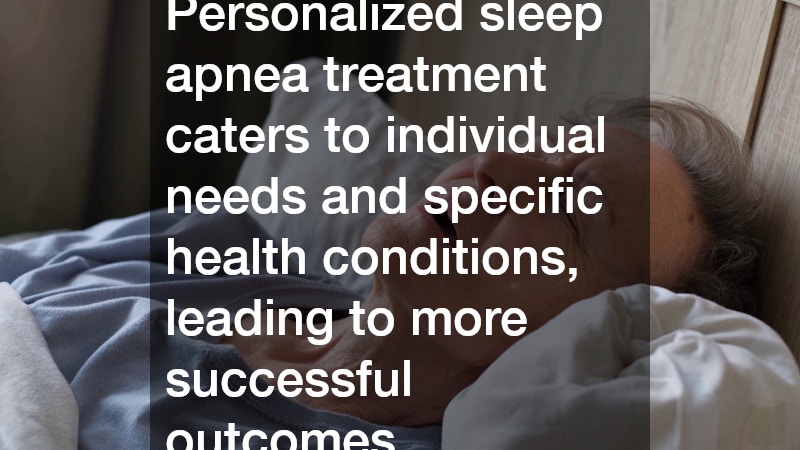Sleep apnea is a common but serious sleep disorder where your breathing stops and starts repeatedly while you sleep. It’s crucial to understand that while sleep apnea can have standard characteristics across various individuals, each case is unique. Therefore, personalized treatment plans are of utmost importance. Personalized sleep apnea treatment in Valley Village, CA not only enhances the effectiveness of managing sleep apnea but also caters to individual needs, preferences, and specific health conditions, leading to more successful outcomes and improved quality of life.
In general, sleep apnea can considerably affect an individual’s well-being, leading to problems such as daytime fatigue, heart problems, and even type 2 diabetes. This makes understanding the specifics of one’s condition critical in tailoring a treatment that is not only optimal but also sustainable in the long run.
Addressing specific symptoms and lifestyle factors is key to managing sleep apnea effectively, highlighting why a one-size-fits-all approach may not be suitable.
Often, individuals are unaware of the critical role personalized care plays in managing sleep disorders. This article aims to delve into why personalized treatment plans are essential in addressing sleep apnea and how these plans can be intricately developed to serve those in need best. By employing personalized strategies, individuals are better equipped to address the complex needs their symptoms present, ensuring a more manageable path to health improvement.
Why is it crucial to have a personalized treatment plan?
Sleep apnea’s impact varies tremendously from person to person, making personalized treatment plans crucial. Various factors influence these effects, including anatomical differences, health conditions such as obesity or diabetes, and lifestyle factors like smoking or air quality. Personalized treatment allows for addressing these distinctive factors, ensuring that interventions resonate well with the individual’s specific health scenario, thereby maximizing efficacy.
Furthermore, a personalized plan fosters a deeper engagement in the management of sleep apnea. When treatments are specifically tailored, they speak directly to personal experiences and health circumstances. This connection is vital as it encourages active participation in treatment adherence, which is potentially challenging without personalization. By seeing the direct impact of tailored interventions, individuals are more motivated to pursue their unique treatment regimen diligently.
Moreover, the variability in responses to standard treatments like CPAP (Continuous Positive Airway Pressure) highlights the need for personalization. While CPAP is effective for many, others may find it uncomfortable or difficult to sustain over time. Alternatives or adjunct strategies, such as lifestyle modifications, positional therapy, or surgery, should be considered based on the individual’s preferences and specific health needs to ensure comprehensive management. Personalization in treatment allows for broader, more adaptable solutions to be explored.
How can a personalized treatment plan be developed?
Developing a personalized treatment plan begins with a thorough diagnostic assessment. This involves sleep studies or polysomnography to determine the severity and pattern of apneas occurring during sleep. Understanding whether the sleep apnea is obstructive, central, or complex dictates the approach and solutions offered. A specialized sleep clinician plays a critical role in analyzing these assessments to guide personalized intervention selection.
Following the assessment, collaboration between the patient and healthcare provider is essential. This relationship is crucial for discussing lifestyle, symptoms, and potential barriers such as claustrophobia with CPAP or concerns about surgery that may affect adherence to a particular treatment. Based on this dialogue, goals can be set collaboratively, taking personal preferences and unique health factors into account, which is imperative for constructing a realistic, sustainable, and effective treatment plan.
Implementing changes as part of a personalized treatment plan should include iterative reviews and modifications. Regular follow-ups are a must to assess the effectiveness of interventions and remain responsive to changes in the patient’s condition or lifestyle. The agility to adapt the methods employed when new challenges or health changes arise facilitates ongoing success in managing sleep apnea, reinforcing the plan’s personalized nature. A dynamic plan ensures that changes to medications, therapies, or lifestyle adjustments are made as needed.
Conclusion
In summary, a personalized treatment plan for sleep apnea is not merely beneficial but essential. It recognizes the uniqueness of each individual’s condition and addresses specific needs, which standard treatments may overlook. Taking this tailored approach enhances the effectiveness of interventions and improves adherence, leading to better health outcomes. This need for personalization is further underscored by the significant variability in sleep apnea symptoms and responses to treatments.
The benefits of personalized treatment transcend improved symptom management; they also encompass lifestyle enhancements and reductions in other health risks associated with untreated sleep apnea, such as hypertension or heart disease. The move towards personalization empowers individuals to reclaim control over their health, leading to improved quality of life and greater satisfaction with sleep health interventions.
Ultimately, a personalized approach offers a profound understanding of an individual’s unique requirements and challenges. By doing so, sleep apnea management becomes more precise and effective, paving the way for not just short-term relief but long-term well-being. Individuals are encouraged to engage in open communication with healthcare providers to realize the full potential of personalized sleep apnea treatment plans.




